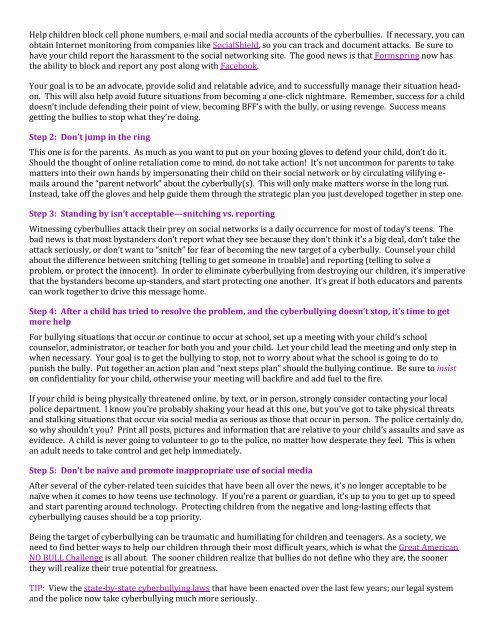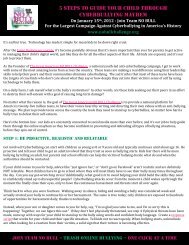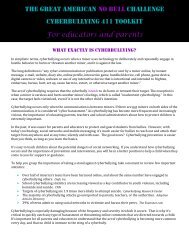The Great American NO BULL Challenge cyberbullying 411 toolkit ...
The Great American NO BULL Challenge cyberbullying 411 toolkit ...
The Great American NO BULL Challenge cyberbullying 411 toolkit ...
You also want an ePaper? Increase the reach of your titles
YUMPU automatically turns print PDFs into web optimized ePapers that Google loves.
Help children block cell phone numbers, e-mail and social media accounts of the cyberbullies. If necessary, you can<br />
obtain Internet monitoring from companies like SocialShield, so you can track and document attacks. Be sure to<br />
have your child report the harassment to the social networking site. <strong>The</strong> good news is that Formspring now has<br />
the ability to block and report any post along with Facebook.<br />
Your goal is to be an advocate, provide solid and relatable advice, and to successfully manage their situation headon.<br />
This will also help avoid future situations from becoming a one-click nightmare. Remember, success for a child<br />
doesn’t include defending their point of view, becoming BFF’s with the bully, or using revenge. Success means<br />
getting the bullies to stop what they’re doing.<br />
Step 2: Don’t jump in the ring<br />
This one is for the parents. As much as you want to put on your boxing gloves to defend your child, don’t do it.<br />
Should the thought of online retaliation come to mind, do not take action! It’s not uncommon for parents to take<br />
matters into their own hands by impersonating their child on their social network or by circulating vilifying emails<br />
around the “parent network” about the cyberbully(s). This will only make matters worse in the long run.<br />
Instead, take off the gloves and help guide them through the strategic plan you just developed together in step one.<br />
Step 3: Standing by isn’t acceptable—snitching vs. reporting<br />
Witnessing cyberbullies attack their prey on social networks is a daily occurrence for most of today’s teens. <strong>The</strong><br />
bad news is that most bystanders don’t report what they see because they don’t think it’s a big deal, don’t take the<br />
attack seriously, or don’t want to “snitch” for fear of becoming the new target of a cyberbully. Counsel your child<br />
about the difference between snitching (telling to get someone in trouble) and reporting (telling to solve a<br />
problem, or protect the innocent). In order to eliminate <strong>cyberbullying</strong> from destroying our children, it’s imperative<br />
that the bystanders become up-standers, and start protecting one another. It’s great if both educators and parents<br />
can work together to drive this message home.<br />
Step 4: After a child has tried to resolve the problem, and the <strong>cyberbullying</strong> doesn’t stop, it’s time to get<br />
more help<br />
For bullying situations that occur or continue to occur at school, set up a meeting with your child’s school<br />
counselor, administrator, or teacher for both you and your child. Let your child lead the meeting and only step in<br />
when necessary. Your goal is to get the bullying to stop, not to worry about what the school is going to do to<br />
punish the bully. Put together an action plan and “next steps plan” should the bullying continue. Be sure to insist<br />
on confidentiality for your child, otherwise your meeting will backfire and add fuel to the fire.<br />
If your child is being physically threatened online, by text, or in person, strongly consider contacting your local<br />
police department. I know you’re probably shaking your head at this one, but you’ve got to take physical threats<br />
and stalking situations that occur via social media as serious as those that occur in person. <strong>The</strong> police certainly do,<br />
so why shouldn’t you? Print all posts, pictures and information that are relative to your child’s assaults and save as<br />
evidence. A child is never going to volunteer to go to the police, no matter how desperate they feel. This is when<br />
an adult needs to take control and get help immediately.<br />
Step 5: Don’t be naïve and promote inappropriate use of social media<br />
After several of the cyber-related teen suicides that have been all over the news, it’s no longer acceptable to be<br />
naïve when it comes to how teens use technology. If you’re a parent or guardian, it’s up to you to get up to speed<br />
and start parenting around technology. Protecting children from the negative and long-lasting effects that<br />
<strong>cyberbullying</strong> causes should be a top priority.<br />
Being the target of <strong>cyberbullying</strong> can be traumatic and humiliating for children and teenagers. As a society, we<br />
need to find better ways to help our children through their most difficult years, which is what the <strong>Great</strong> <strong>American</strong><br />
<strong>NO</strong> <strong>BULL</strong> <strong>Challenge</strong> is all about. <strong>The</strong> sooner children realize that bullies do not define who they are, the sooner<br />
they will realize their true potential for greatness.<br />
TIP: View the state-by-state <strong>cyberbullying</strong> laws that have been enacted over the last few years; our legal system<br />
and the police now take <strong>cyberbullying</strong> much more seriously.








